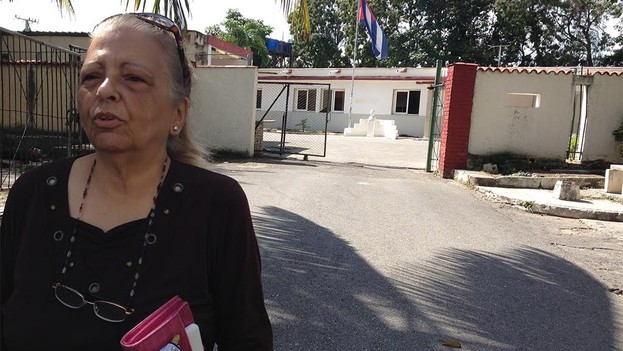
![]() 14ymedio, Havana, 21 of January, 2020 – The Lady in White Xiomara Cruz Miranda arrived in Miami on an American Airlines flight from Havana on Tuesday, to be treated for a disease she contracted in prison in the middle of last year without receiving effective medical care. Her relatives have reported constant irregularities in her diagnosis and treatment.
14ymedio, Havana, 21 of January, 2020 – The Lady in White Xiomara Cruz Miranda arrived in Miami on an American Airlines flight from Havana on Tuesday, to be treated for a disease she contracted in prison in the middle of last year without receiving effective medical care. Her relatives have reported constant irregularities in her diagnosis and treatment.
Cruz Miranda received a humanitarian visa after months of efforts, initiated on August 14th, as Berta Soler — leader of the women’s group — told 14ymedio. Ángel Moya (Berta’s husband), has been another major activist on the Island.
In addition, on the other side of the Florida Straits she has had help from other fellow activist: exiled María Elena Alpízar, as well as Iliana Curra and Mercedes Perdigón, both political ex-prisoners, and from others in exile who started a petition addressed to the US congressman of Cuban origin Mario Díaz-Balart. continue reading
“Thank God she must be landing already, everything went well on this side, now we are awaiting her arrival. There is a team of doctors there, focused on improving her well-being and on getting her a diagnosis. The Cuban American National Foundation invited her and will take care of all expenses. An ambulance is waiting there for her and everything is ready to assist her as soon as she arrives”, indicated Soler.
“With everything that happened with Laura Pollán and Oswaldo Payá Sardiñas any activist is at risk when they enter a hospital, because State Security has doctors at their disposal, doctors who will always follow their orders. We don’t trust them and thus of doctors who do not receive orders from the Cuban regime,” she added.
At the airport, she was received by the Cuban doctor Alfredo Melgar. “First, will get a comprehensive diagnosis of Xiomara and then we will put her under treatment,” Melgar told the New Herald, who accompanied her to the hospital. The doctor asked the community for help to welcome Cruz Miranda and her daughter, who accompanies her on this trip.
Martha Beatriz Roque had also announced the news on her social media yesterday (on Monday): “With God’s favor she arrives tomorrow in Miami,” she celebrated.
the Lady in White’s state of health has worsened in recent weeks, with a last relapse that began on December 26th and extended until January 10th, but it remains unclear what disease afflicts her.
From the beginning, Cruz Miranda has been diagnosed with tuberculosis, but her relatives and friends have expressed doubts to the point of accusing the Government of having inoculated her with a virus to make it difficult — or worse — to prevent her from continuing to exercise her political opposition. That suspicion aligns with that expressed by Ariel Ruiz Urquiola, who has been denouncing, for months, that the regime has infected him with HIV.
Xiomara was sentenced in 2018 to one year and four months in jail for “threats” in a trial described as rigged by Berta Soler, leader of the Ladies in White. The first prison she went to, was El Guatao (West of Havana), and subsequently she was transferred to a prison in Ciego de Ávila.
Last August, the Government granted her conditional release when health problems arose, and she was transferred to La Covadonga hospital in Havana, where she was admitted into intensive care.
Relatives have also considered that the Lady in White has cancer, as mentioned by the Cuban Alliance for Inclusion and the Cuban Women’s Network in a protest note condemning the situation in which the Government held the activist and asking international organizations to take action for her safety and her defense.
“Her muscular pains worsened, as well as the intermittent fever. Doctors have confusedly declared, everything from a disease caused by an unidentified bacteria, to even mentioning cancer. Which has baffled relatives, friends and fellow activists, who request her release to take her to another country in order for her to receive proper medical attention immediately,” both women’s organizations were asking for last fall.
Translated by: Rafael (Tampa, Florida)
_____________
COLLABORATE WITH OUR WORK: The 14ymedio team is committed to practicing serious journalism that reflects Cuba’s reality in all its depth. Thank you for joining us on this long journey. We invite you to continue supporting us by becoming a member of 14ymedio now. Together we can continue transforming journalism in Cuba.















